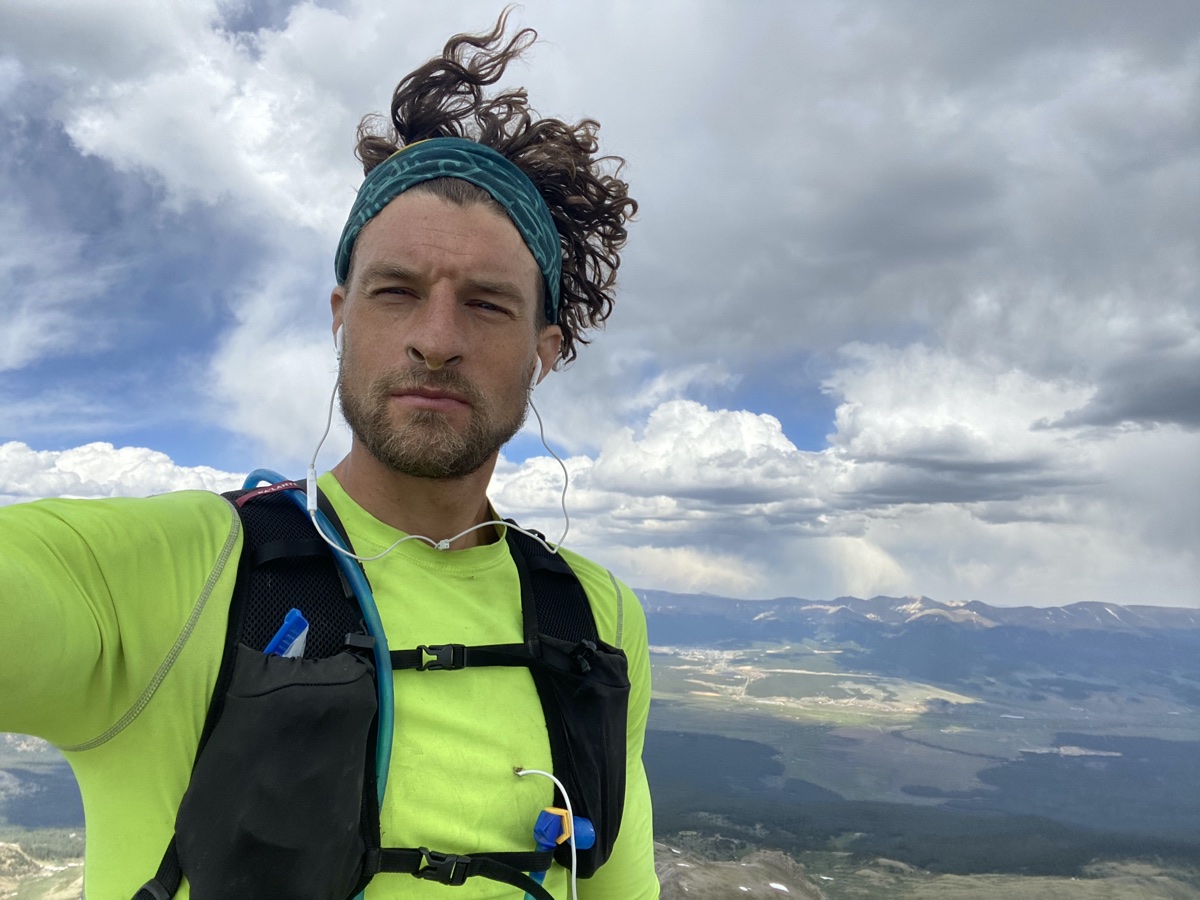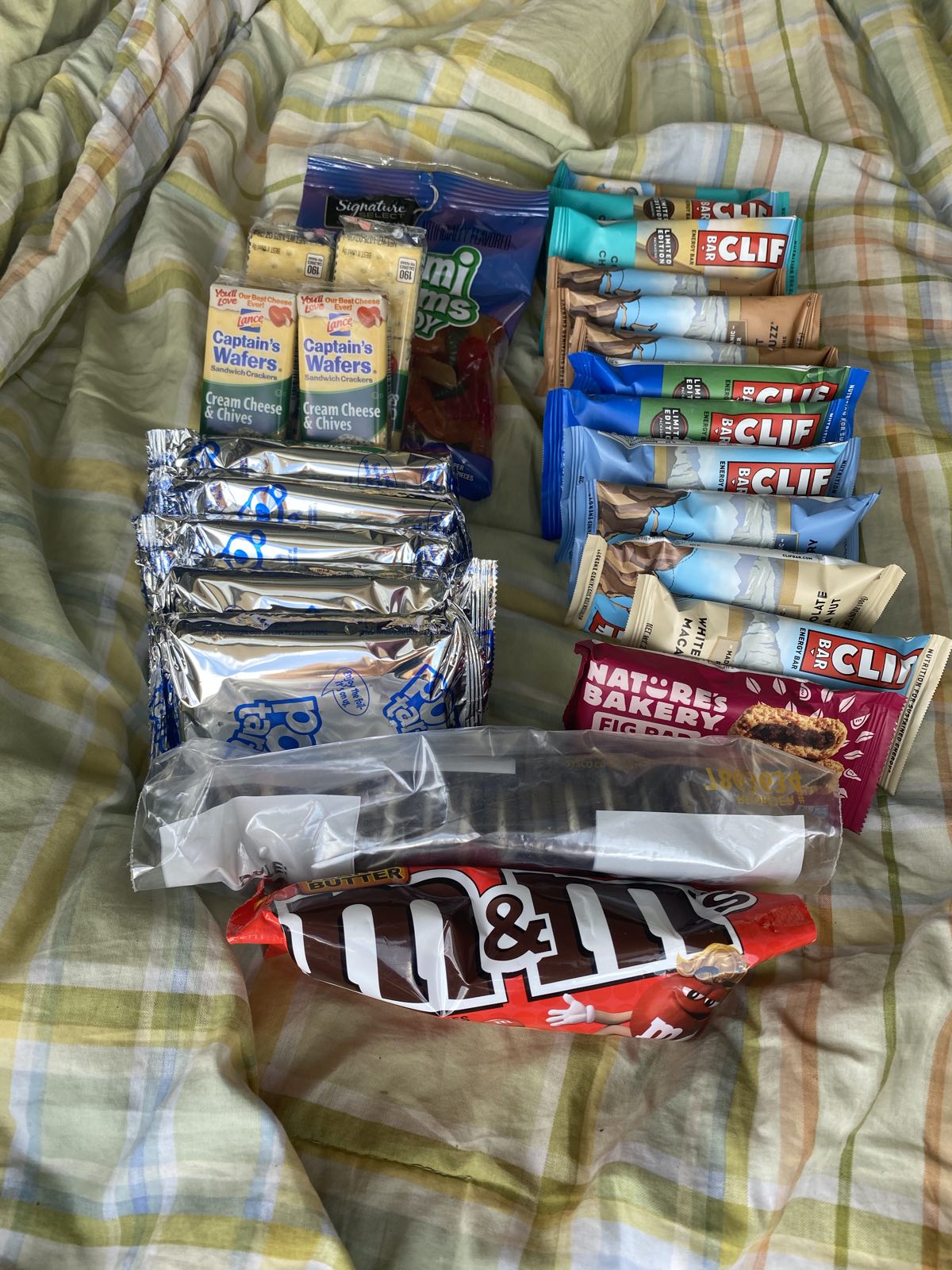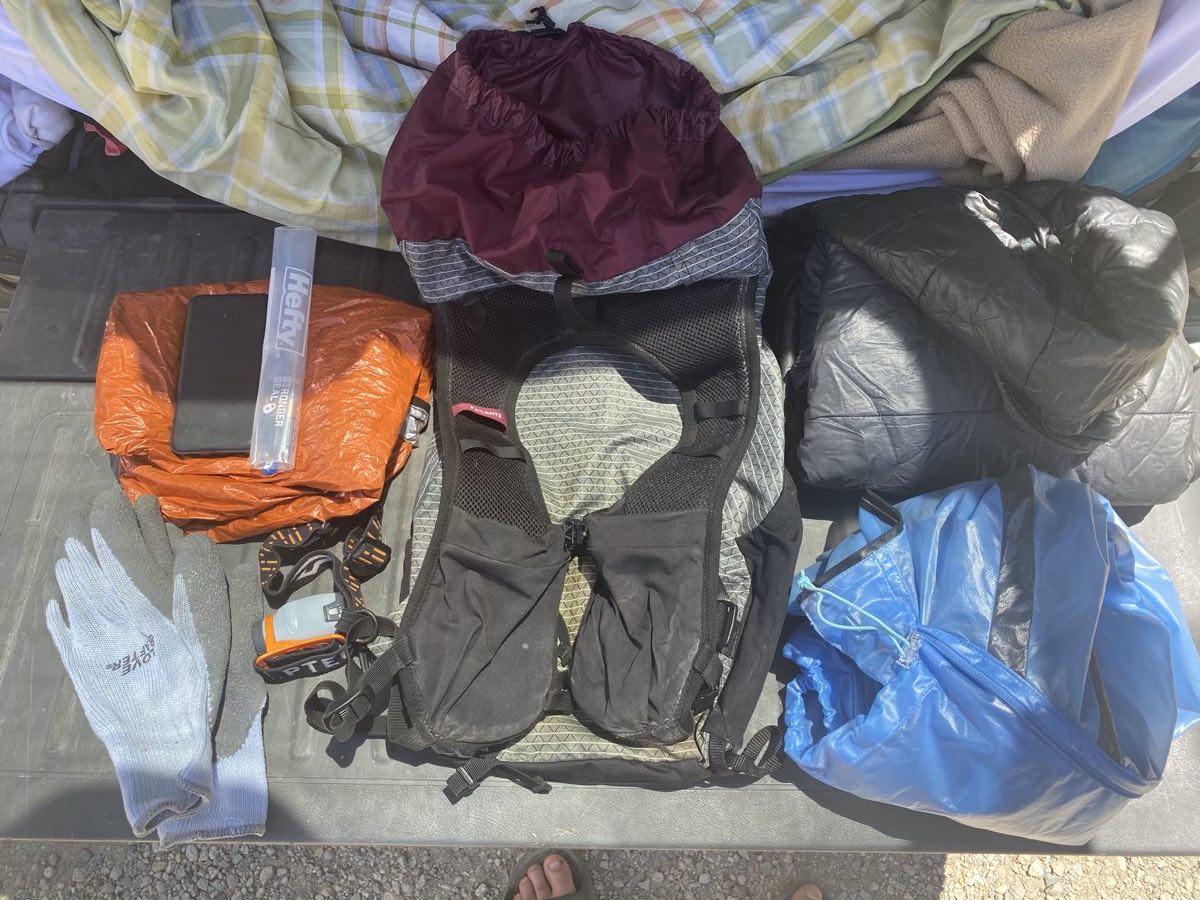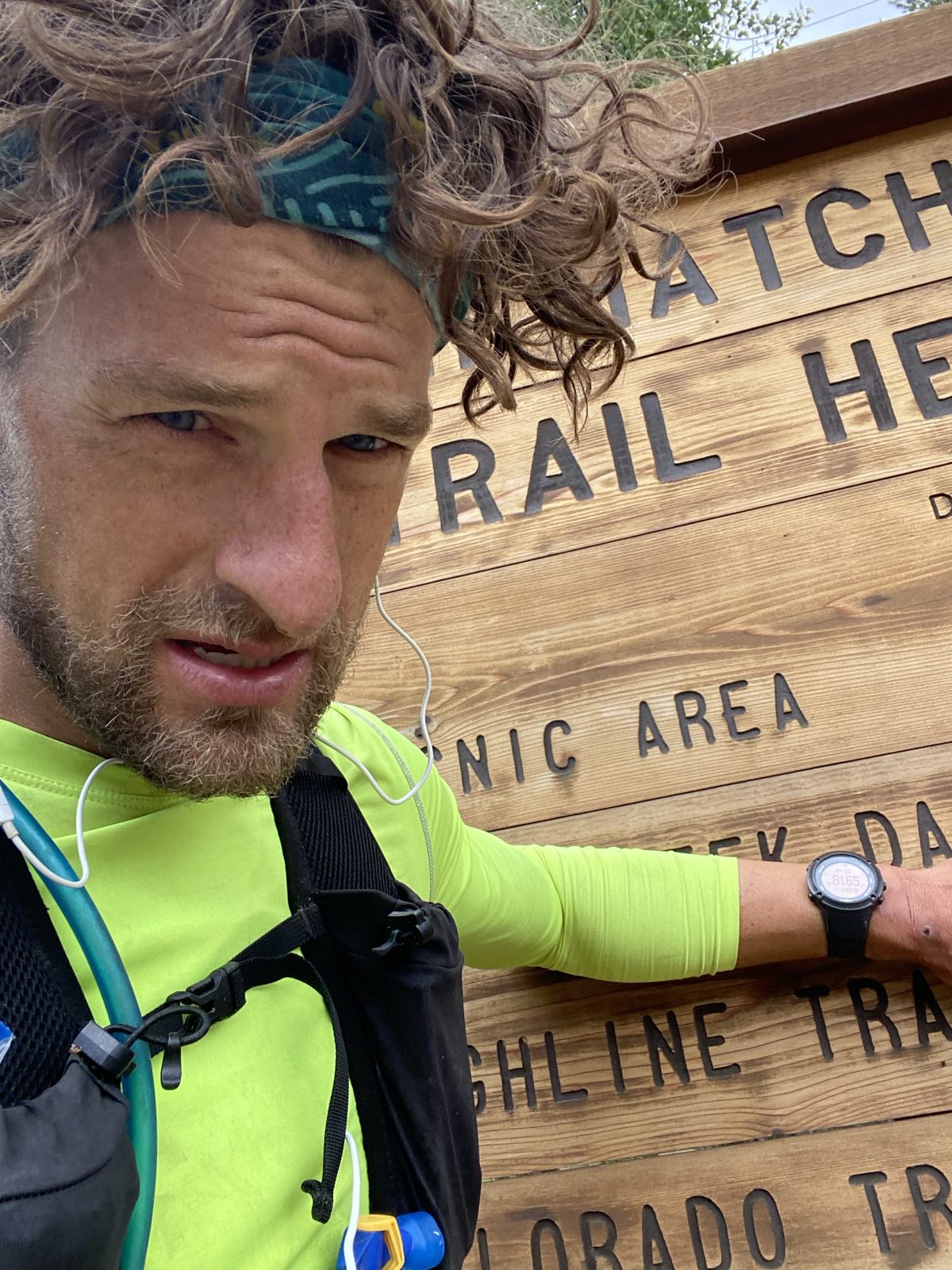On Jul 1 and 2, 2020, 33-year-old Joey Campanelli set a new unsupported and overall men’s fastest known time on the Nolan’s 14 line in the Sawatch Range of Colorado in 41 hours even, in the process bettering both the previous unsupported men’s speed record of 49:38 set in 2018 by Joe Grant as well as the previous supported men’s speed record of 46:48 set in 2018 by Alex Nichols.
The Nolan’s 14 line is a link-up of 14 mountains in excess of 14,000 feet in elevation. Athletes can connect the summits by whatever routes they choose, but routes commonly add up to about 95 miles in length, about 44,000 feet of climbing, and about half off trail.
This is a transcript from a phone interview with Joey after his outing. In this interview, Joey talks about the logistics of pacing and what was in his unsupported kit, how he entered a flow state for the whole outing, how his effort played out, and how he thinks others can continue to improve their pacing on the line.
iRunFar: Thanks for agreeing to this interview.
Joey Campanelli: Of course!
iRunFar: We have mutual friends, but haven’t met. I’d love to learn more about you. You live on Wasatch Front [in Utah], or do you live up one of the canyons there?
Campanelli: Yeah, I live in Alta [in Little Cottonwood Canyon].
iRunFar: What do you do for a living?
Campanelli: I work at a hotel for the ski resort and I do maintenance. We’re only open for the winter, so for the summer we do renovation projects and stuff like that.
iRunFar: Is that why you’re able to do thru-hiking and longer stuff, because summer is your down season?
Campanelli: Yeah. Usually I just work as much as I feel like I need to, for money. The Wasatch is great, so I don’t mind being here, but I had planned to take this whole summer off work before the coronavirus.
iRunFar: You do mountain running. What would be the best way to describe your winter activities? Do you do ski-mountaineering racing? Do you ski tour?
Campanelli: Backcountry skiing. I race a little bit, but not really.
iRunFar: You also thru-hike, right?
Campanelli: I’ve done the Appalachian Trail [AT] twice and the Pacific Crest Trail. One of the things that has been in the back of my mind for this summer was the Colorado Trail. I was going to do that unsupported.
iRunFar: Is that potentially still on your mind?
Campanelli: Yeah, but there’s a very small chance [it will be possible]. Maybe 5%.
iRunFar: Where did you grow up?
Campanelli: I’m from upstate New York, from Albany. In 2008, I moved to San Francisco, [California] and then I moved to Utah in 2010.
iRunFar: Did you play sports growing up?
Campanelli: Hockey and soccer were my two sports. It was a lot of anaerobic stuff. I always say I should be a sprinter [as opposed to these endurance pursuits] because I have that strength, but I think I just do well with suffering [laughs].
iRunFar: You probably have residual power in your legs for these super-steep things.
Campanelli: I lifted for hockey really hardcore into college and then I just lifted. I used to be huge, like 200-plus pounds. I would guess that I’ve lost at least 30 to 35 pounds of muscle in 12 years.
iRunFar: Wow! How did you get your trail name, Flash? Is that a self-evident reference to your speed?
Campanelli: [Laughs] Well, I was hiking up the approach to Springer Mountain my first time [on the AT] and I went by [another thru-hiker with the trail name] Gumbo. We both spent the night at the Springer shelter and she goes, “Do you have a trail name yet?” I had these bright green and pink shorts and a pink shirt and rainbow-colored shoes on. I was nice and bright. She says, “I’m going to call you Flash.” It stuck from there.
iRunFar: You’re also pretty fast at whatever sport you do.
Campanelli: I mean, it’s still more of a reference to my outfits. I like to be bright, kind of make a scene.
iRunFar: Amazing. So, I learned of you in 2018 because you attempted the Nolan’s 14 with our mutual friend, Hannah Green. When did Nolan’s first come onto your radar?
Campanelli: I went out there to visit a girlfriend in 2012 and went to Buena Vista[, Colorado]. I fell in love with the area. I did the Leadville Trail 100 Mile, I think that was my first 100 miler. Someone said, “Have you ever thought about doing the Nolan’s 14?” I was like, “Wait, what’s that?” I got interested in it that way, I guess.
[The year] 2018 was the first time, where I got out a few times to scout it. It was a good “training camp” vacation. I trained there. I did the AT in 2014, and that wrecked me. I did the PCT in 2015, and then the AT again in 2017. So, I didn’t have very many opportunities [to spend time on Nolan’s]. In 2016 I did a 2,500-mile bike tour out to Colorado but I didn’t do as much running as I thought I might do during that trip. So, 2018 is when I went out there to give it a real good go, and I met Hannah and her friend Kyle Curtin in a parking lot.
I started with Hannah and Kyle. Kyle was seeing how much he was up for, just scouting. He bailed before [halfway]. Hannah and I limped on, or whatever you want to call it. It was day four for me in Colorado, so I was just starting to feel the altitude. I really struggled on the first and second day. On the third day I felt amazing. I finished just ahead of Hannah by a few hours.
iRunFar: And incredibly, I think you finished a couple minutes before the 60-hour cutoff.
Campanelli: I was on top of Mount Massive [the final mountain] and was like, “I’ve gotta’ sprint.” I’ve had to do that twice now, going down Massive as fast as you can.
iRunFar: The Massive super-sprint.
Campanelli: Yes, it’s out of control.
iRunFar: So, Nolan’s must have gotten under your skin in a good way. I saw you posted a photo in which you said, “For a long time I’ve been thinking about doing this again, but in 44 hours.”
Campanelli: I love the Sawatch Range. It’s an absolutely beautiful mountain range and a line that goes over the all of the high peaks is the cleanest way, aesthetically, to move through a mountain range. I wanted to do Mount Holy Cross, too, and add in that whole idea. Doing Nolan’s in sub-44, that’s what I thought I could do, and that’s what I was shooting for.
iRunFar: How did you get your mind around the idea of finishing in 44 hours?
Campanelli: I Not to insult anyone else, but I think a lot of people just go out there and do it [without spending enough time to scout it]. I did Princeton 20 times and figured out which way to go down it. I’ve done seven different descents of that peak. I think when you’re going to do a line like that, you want to do it justice and study. If you know it really well, it makes a huge difference. I think for me what was big with Nolan’s was the altitude, so I had a Hypoxico tent for four weeks before I went out there. I was sleeping at 15,000 feet every night.
iRunFar: How was that?
Campanelli: It’s actually okay. It’s not super fun, but it’s okay.
iRunFar: You went unsupported. Can you clarify what that means?
Campanelli: Yeah. You skim water out of creeks, but you carry all of your food and whatever your shelter is going to be from start to finish.
iRunFar: What did your pack weigh?
Campanelli: I would say it was just under four pounds.
iRunFar: How many calories of food did you bring?
Campanelli: I probably had 7,200 calories.
iRunFar: What did you fuel on? What were those calories?
Campanelli: It was 12 Clif Bars, four Pop-Tarts, cheesy cracker snack packs, some Oreos, and some peanut butter M&Ms.
iRunFar: No liquid calories? You drank straight water?
Campanelli: Straight water. I didn’t want to make a mess of things. I just scooped up water and went.
iRunFar: How did the food go down?
Campanelli: It was fine. I ate pretty regularly during Nolan’s, but I wasn’t really hungry.
iRunFar: What did you carry for [clothing] layers, kit, and headlamp?
Campanelli: I wore compression socks and compression sleeves on my legs, so I didn’t bring anything extra for legs. I had my compression top, a puffy, and a rain jacket. I had a Princeton Tec headlamp and classic Black Diamond trekking poles. And I wore a Buff. That was it.
iRunFar: You must have only carried like a 10-liter pack?
Campanelli: The pack company that I work with is Pa’lante Packs. I used my thru-hiking pack, which I think is 27 liters, but it was basically empty. The pack had a front pocket, two side pockets and an underneath pocket. My rain coat just goes on and off without even taking the pack off. Pretty much all of my food was on the outside, so I never had to take the pack off to eat. Basically I’m just pulling the bladder out over my head, scooping it in the creek, and going. The packs are really efficient for that reason.
iRunFar: Can we walk through your route, part by part? Did you start at midnight?
Campanelli: I would’ve liked to start at midnight–that would be nice and clean–but I think it was 12:04 a.m. [laughs]. I tried to go to bed early and tried to eat a bunch of bread and food in the heat of the day around 3:00 p.m. at the trailhead, trying to make myself go comatose. I passed out around 4:00 and when I got to 11:30… it takes me a long time to get ready before going out. I was like, “Oh no! Gotta’ go!”
iRunFar: You actually slept from 4:00 p.m. until 11:30 p.m.?
Campanelli: Yeah. That’s what I tried to work out, because it’s the best. You figure, if you plan on going 45 or 46 hours, I only want one night in the dark. I see the midnight start as a really early morning, and then you have one night that you have to go through, and then you finish before sunset on the second night.
I think my trick was to be a little dehydrated, eat food, and then pass out. I basically ate like 5,000 calories and then fell asleep.
iRunFar: So, you shoved off just a little after midnight. Daylight must have come as you were going down Mount Antero?
Campanelli: I got to [the tiny enclave of] Alpine and it was twilight, and then I got the sunrise as I was heading up Grouse Gulch.
iRunFar: How was that segment in the dark?
Campanelli: I did it twice previously. When I did it before when I started at midnight and did it in the dark, I liked that section in the dark. The descent is what it is. You do it in the dark, it’s not that much different.
iRunFar: Did you have any interesting occurrences in the night? Animals or the moon or anything?
Campanelli: No, but when I was going down Tabeguache there was a buttload of cairns in the woods when you get down toward the creek. I thought that was the weirdest thing: “Who the hell is building cairns out here?”
iRunFar: You posted on your Instagram your split differences between you and [previous supported men’s record holder] Alex Nichols. Early on it looked like you were making up time mostly on the descents.
Campanelli: It seemed like a lot of my time [gain] was on the more technical sections or the descents, yeah.
iRunFar: Were you pushing it? Was there a conscious strategy there?
Campanelli: I think that’s what I’m good at. I always think, “Oh, I’m going my normal pace” on a rocky, technical section. Then I’ll look at Strava later and it’s, “Oh, yeah, that was a top-10 time or something.” I think that’s just my skillset.
iRunFar: From living at Alta and running there.
Campanelli: It blew my mind. I gained on most of the downhills. Eventually I gained time on the uphills, just gained a little everywhere–a little here, a little there, you know.
iRunFar: Once you got to the mid-point, it seems like you shaved time off every split that you listed.
Campanelli: I think the most surprising one was Missouri Mountain. But when I think about it, that’s where I did the East Ridge [route]. I got 55 minutes from Mount Belford to Missouri, and that seems like a lot.
iRunFar: That’s a split for a really fast, fresh person. Had you ever moved that quickly between the two mountains before?
Campanelli: Yeah, I did it twice earlier that week. I don’t know exactly my split, but I don’t think I went faster during my attempt.
iRunFar: With Nolan’s there are general lines, but then people take their own bent on it. What kind of terrain did you look for on the uphills and the downhills?
Campanelli: For the uphills, the more solid and steep, the more I like it. I think if I’m fresh and going up one peak for a training run, I don’t mind if it’s a little loose. You just muscle up it or whatever. When you’re tired, like going up Mount Columbia on that 40-degree stuff and it’s a little loose, I’m just slower on my reaction time and it isn’t ideal. Downhill, I like those beautiful scree slides.
iRunFar: You were posting videos from all of your summits. How many peaks did you make it through in 24 hours?
Campanelli: I got to Missouri [the 10th peak] in 22:21.
iRunFar: In your video it sounded like there was surprise in your voice.
Campanelli: I realized I had done ten 14ers in 24 hours. I don’t really care, but I seem to recall that was someone’s record for how many 14ers they’ve done in 24 hours. I was like, “Oh sweet! I just did that as part of Nolan’s.” So surprise is right [for describing how I felt at the time].
iRunFar: You had your watch going and were able to see your progress. At any point along the way were you like, “Um, am I doing this right?”
Campanelli: Yeah. I basically was going along by feel, that’s how I always go. I entered this flow state and didn’t leave it. I was like, “Holy shit, you’re going so fast right now. You’re so far ahead. You could finish in 40 hours.” I didn’t slow down or stop, but I did remind myself that things go great until they don’t. All it takes is one really bad spot and it takes you five hours to get up one.
iRunFar: I wanted to ask you about your inner psychology. You commented on that in a couple of your videos. It sounded psychologically very comfortable.
Campanelli: There’s nothing greater than entering a flow state. It was literally effortless for me. You enter a flow state and you’re just moving, you don’t feel anything. I had that for literally 40 hours. I’ve never experienced anything like that before. You can perform way better when you’re in the flow than when you’re not.
iRunFar: Can you invoke that feeling, or is it spontaneous?
Campanelli: It has to “happen,” but I do think you create it in a sense of like… this is all I thought about for a long time. I thought about it prior, but from May 1, everything was like, “I’m doing Nolan’s. Nolan’s. Nolan’s. Nolan’s. Is this salad helping me? Is this training helping me? Is this wasted conversation helping me when I could be resting or stretching?” I thought about Nolan’s a lot and I invested a lot of mental time in it. I think when you do that, put in that much investment, then when you finally get there, your body and mind are like, “Oh, this is what you were talking about.”
iRunFar: When I think of the south-to-north direction, the last three mountains are pretty big humps but the route is clear. I think of Huron Peak as the cusp, where if you make it to that point, you’re pretty much there. What did it feel like getting over the hump and getting onto that home stretch?
Campanelli: I was feeling pretty good getting over Missouri. I was like, “Don’t step wrong.” Going up Huron, I got to the basin, sat down, ate a Clif Bar, and was like, “All right. This is the last bit. Time for cruise mode.” Once I got up to that saddle, I was like, “You got this.”
iRunFar: When did daytime come again for you?
Campanelli: Sunrise came at the top of La Plata Peak. I had this time where my eyes started getting really blurry. I thought my contact lenses were getting messed up but then I literally scratched the corneas and felt this damage. My right eye was just blurry and I felt drunk going down the trail.
iRunFar: Wow! You were still making good time, though.
Campanelli: Yeah, I was moving well, but I think I ate shit three times going down from La Plata.
iRunFar: In the second night, did anything interesting happen?
Campanelli: I didn’t quite have a full-on experience, but that road section from Huron to La Plata, I kind of left my body and floated. I was watching my legs under the headlamp light. I was kind of just like, “What is this crazy person doing in the middle of the night running down the road?” But I didn’t get too crazy or anything like that.
iRunFar: Sunrise came when you were on La Plata. In a couple of places, you probably saw normal hiker traffic, right?
Campanelli: I passed five or six people on the trail going down La Plata. There were like 30 people on top of Mount Elbert.
iRunFar: Was it strange to have been by yourself for so much time and then see people?
Campanelli: I wouldn’t say strange. It was like, “Oh, I’ve gotta’ social distance and tag the peak.” It was more annoying than weird.
iRunFar: By this point, you’re just really far ahead of the record. Was your mentality still one of “Every minute counts,” or did you decide to cruise because you were so far ahead of the record?
Campanelli: There was no cruising, but I wasn’t putting crazy undue urgency to get every second. I kind of started thinking, “Could you go sub-40? That would be so sweet.” I was going up Elbert and you know how it goes up Bull Hill. I was like, “I’ll be there in 20 minutes.” An hour later, I was like, “Oh well. Keep going, you’ll be there soon.” Massive was like that, too. I actually moved well, but it was that “crawling up the mountain” mess at the end.
iRunFar: Then you sprinted the last downhill.
Campanelli: I wanted to be done [laughs]. I like that kind of… I’ve done that descent four or five times. I like it. It gets a rhythm. When I got to the top of Massive, my legs were pretty beat and my head and my energy were just drained. I was thinking it would take me three hours to get down. I told myself, “Just start moving, start descending, and you’ll feel better. You’ll get your energy back.” I just started walking and within two minutes it was “This isn’t so bad.” In five minutes it was, “This is good.” In 10 minutes it was “Let’s finish this!”
iRunFar: You managed to pop a few nine-minute miles as you headed into the finish going down the Fish Hatchery, according to Strava.
Campanelli: I thought I was going five-minute miles [laughs], but nine sounds about right.
iRunFar: I think nine is still pretty good at this point in your effort
Campanelli: Nine is pretty good, but in your mind you’re like, “I’m going so fast!”
iRunFar: When you’re doing this unsupported and you pull up to the trailhead, you were by yourself. What was that like?
Campanelli: When I showed up at the Fish Hatchery, there was no one. I had a drop bag there and I was going to do Holy Cross, but I had pushed myself so hard. Once you start realizing that you’re getting a good time, I kept pushing. My thought had originally been to finish at 9:00 p.m. and take a three- or four-hour nap and then just have a fun recovery day at Holy Cross. But I had scratched my eye and couldn’t see. I was sore from sprinting at the end. I was like, “Yeah, I’m pretty satisfied from that.”
iRunFar: You just posted a video of you erasing “sub-44” from your adventure whiteboard and replacing it with “sub-40.” Is that for real?
Campanelli: It might be a while before I try that one, but who knows? I like to keep that list with my goals and ideas up there and I make notes to myself.
iRunFar: You must be feeling pretty good sitting on the couch and relaxing right about now.
Campanelli: I’ve got my legs up right now. It took me three days to drive home because I was so comatose. I just wanted to sleep. When I’m awake, I had energy, but then 30 minutes later I’d want to sleep. My feet are still swollen and then my hand was infected. But I’ll go for a run tomorrow.
iRunFar: My last question, for people who have been following Nolan’s for a long time, they’re saying that what you did is shifting the perspective of what can be done. Where is your head? Had the perspective already shifted for you?
Campanelli: I’m proud if that’s the shift that I’ve helped create. If that’s what I’ve done, then great, that’s awesome. I think if people really study a line and go all in on it, they can do a lot more than they think. I have definitely thought people could go faster for a long time. People have thought they could. They look at it on paper and say, “It’s not even 100 miles and it’s only 45,000 feet of climbing. Someone should be able to do that in–and I’m just making up numbers here–30 hours or whatever.” Then they get there and realize it’s so much harder than that. But if you study the route and get acclimated and put in the time and devote yourself to it, it’s definitely starting to trend back to the route as you see it on paper. People just need to put a little more effort into studying it and doing it.
iRunFar: I like what you said about how more people have a chance. But what you also have is a hard challenge: You gotta’ work for it.
Campanelli: It’s not a gimme route.
iRunFar: Congratulations. That was really fun to watch.





